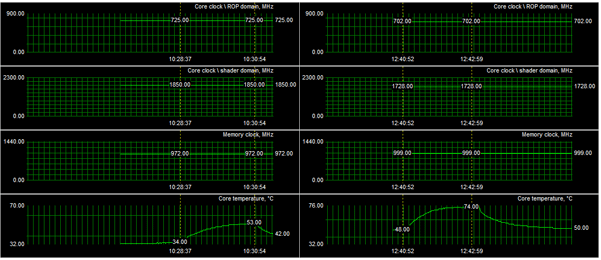4 - Installation | GPU temps | power consumption | noise levels
Setting up the PC
Installing the card into your system will be a pretty easy job. Just slide the card into a free PCIe slot, connect one 6-pin connector to the card. I do recommend you to buy a decent stable PSU with some reserves, always.
Once the card is installed we startup windows. We installed our driver, rebooted and that was it. The card will work straight out of the box. Just the way we like it, for both cards this was the same experience.
Power consumption
It's time to do some actual testing with this card. We'll start off by showing you some tests we have done on overall power consumption of the PC. Looking at it from a performance versus wattage point of view.
Our test system contains a Core 2 Duo E8400 Processor @ 3.0 GHz (FSB 1333), the eVGA 680i SLI mainboard, stock cooling on the CPU, DVD-rom and a WD Raptor drive. The results:
| Wattage (PC total) | Idle | Peak |
| BFG GeForce 9600 GT OCX | 178 | 231 |
| BFG GeForce 8800 GT OCX | 180 | 263 |
A fairly standard power supply will be more than sufficient for this graphics card. Any reasonable 500 Watt PSU and above will suffice. We test a lot of PSUs, check out some good ones over here.
The thermal envelope
Our Rivatuner application is a great one. We used it to monitor monitor heat levels from the GPU.
| Temperature in degrees C | Idle | Peak |
| BFG GeForce 9600 GT OCX | 33 | 53 |
| BFG GeForce 8800 GT OCX | 48 | 74 |
BFG GeForce 9600 GT OCX -- would you just look at the temperatures. That is just amazing. The 9600 GT GPU is so refined and tweaked that it has excellent thermals. Idling at 33 Degrees C is just amazing. And a peak of 53 degrees C .. wow. That promises a lot for overclocking.
BFG GeForce 8800 GT OCX - This card has the same cooler, yet way more transistors for the increased numbers in Shader cores. Here temps are just fine really. 48 C in idle and 74 Degrees C when fully utilized. That still gives us a little headroom for tweaking the product.
 9600 GT OCX 8800 GT OCX
9600 GT OCX 8800 GT OCX
Volume Levels
When graphics cards produce a lot of heat, that heat usually needs to be transported away from the hot core as fast as possible. Often you'll see massive active fan solutions that can indeed get rid of the heat, yet all the fans these days make the PC a noisy son of a gun. I'm doing a little try-out today with noise monitoring, so basically the test we do is extremely subjective. We bought a certified dBA meter and will start measuring how many dBA originate from the PC. Why is this subjective, you ask? Well, there is always noise in the background, from the streets, from the HD, PSU fan etc etc, so this is by a mile or two not a precise measurement. You could only achieve objective measurement in a sound test chamber.
The human hearing system has different sensitivities at different frequencies. This means that the perception of noise is not at all equal at every frequency. Noise with significant measured levels (in dB) at high or low frequencies will not be as annoying as it would be when its energy is concentrated in the middle frequencies. In other words, the measured noise levels in dB will not reflect the actual human perception of the loudness of the noise. That's why we measure the dBa level. A specific circuit is added to the sound level meter to correct its reading in regard to this concept. This reading is the noise level in dBA. The letter A is added to indicate the correction that was made in the measurement. Frequencies below 1kHz and above 6kHz are attenuated, where as frequencies between 1kHz and 6kHz are amplified by the A weighting.
| TYPICAL SOUND LEVELS | ||
| Jet takeoff (200 feet) | 120 dBA | |
| Construction Site | 110 dBA | Intolerable |
| Shout (5 feet) | 100 dBA | |
| Heavy truck (50 feet) | 90 dBA | Very noisy |
| Urban street | 80 dBA | |
| Automobile interior | 70 dBA | Noisy |
| Normal conversation (3 feet) | 60 dBA | |
| Office, classroom | 50 dBA | Moderate |
| Living room | 40 dBA | |
| Bedroom at night | 30 dBA | Quiet |
| Broadcast studio | 20 dBA | |
| Rustling leaves | 10 dBA | Barely audible |
Both in IDLE and active RPM states the fans are hardly noticeable. We measured roughly 40 dBa coming from the PC with any of these cards, and that's just really good.
